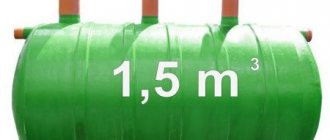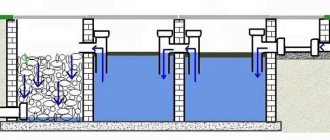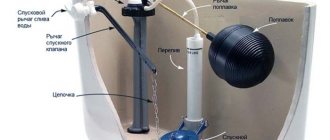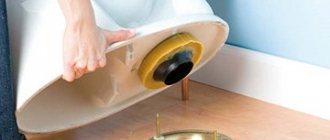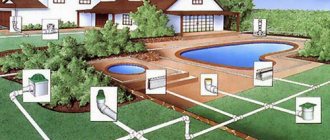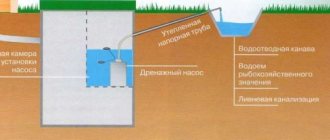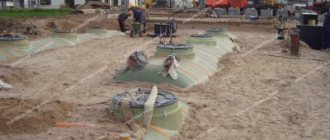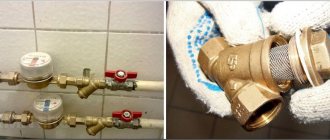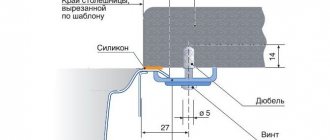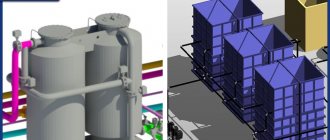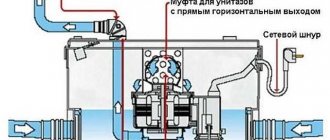Simple type device
The sump tank can be in the shape of a rectangular or round well.
that flows through it flows slowly, allowing sediment to form.
It is not removed until it rots (six months, a year).
The rotting process is accompanied by fermentation and the release of gases, which lift heavy particles upward, forming a crust (sometimes 0.5 m thick).
Types by nature of work
There are different types of settling tanks. They differ in the nature of their work:
- static,
- dynamic.
Static
They are standard reinforced concrete tanks . A static settling tank is used when water flows periodically and its consumption is insignificant.
For cleaning, taps or siphon tubes are used, which are located above the level of impurities. Unloading of settled particles is carried out manually or using special drain devices.
Attention. The advantages of this type include versatility. Additionally, it can be used as a storage or buffer tank.
Dynamic
Used for mechanical water purification. Used for high flow rates of waste liquid. The action is based on the constant movement of water in the process of purifying impurities.
Depending on the direction of water, the dynamic settling tank is divided into three types:
- horizontal;
- vertical;
- radial.
The choice of settling tank type is influenced by:
- terrain conditions;
- concentration;
- quality of undissolved impurities in water;
- groundwater level.
Horizontal
The most common type. It features a rectangular tank shape. Divided into several compartments using longitudinal partitions.
Settled particles in a rectangular settling tank are removed using a transverse tray or a special scraper, which are installed at a certain level.
If coagulation purification of wastewater occurs, the device is equipped with flocculation chambers. The structure has a high lightening effect. The disadvantages of the horizontal view include: not a cheap price for installation work and the presence of zones where precipitation stagnates.
Vertical
The shape resembles a square or cylindrical tank with a conical bottom. The movement of water occurs from bottom to top. The shape of the bottom allows impurities to easily sink to the bottom and be easily removed during further cleaning.
The efficiency of such a settling tank is 10-20% lower than that of a horizontal or radial one.
The advantage of the structure is its ease of operation and design . Disadvantages include greater depth. It increases the cost of installing structures in places with weak soil and high groundwater levels.
Radial
This type of sedimentation tank is a round tank. The movement of wastewater occurs in a radial manner, from the central part to the periphery. This allows you to increase the speed of water movement, which varies from high in the central part to low in the peripheral part.
Particles located on the surface are removed by a suspension device located on a rotating truss. Particles are collected in a collection tray or receiving hopper .
Among the advantages of radial settling tanks are low specific material consumption and ease of operation. The disadvantage is the high gradient velocity in the center, which reduces the volumetric utilization rate.
Static settling tanks
Static settling tanks are used to separate various oil product contaminants from water. This is a long process, up to two days . And the flow of wastewater is very uneven.
Therefore, for such wastewater treatment, large-volume buffer reservoirs are built. Since it is difficult to separate floating impurities without pumping, a scheme with at least two buffer reservoirs is used.
The operating algorithm is as follows:
- filling;
- sucks;
- pumping out.
Buffer tanks level out the unevenness of the volume of wastewater entering treatment plants and make it possible to significantly reduce the concentration of oil.
The main advantage of such tanks is their tightness. They are built using the industrial method, which dramatically reduces construction time.
Differences in purpose
Depending on the purpose in the technological scheme, settling tanks are of two types:
- Primary. Installed before the physico-chemical or biological purification process. Excessive amounts of suspended solids and mechanical impurities (sand) are removed.
- Secondary. Installed after biological treatment at the end of the process flow. They are used to retain activated sludge that comes along with purified water. As well as biological film.
Plate sedimentation tanks
Plate sedimentation tanks contain parallel plates with liquid moving between them.
Based on their relative positions, there are types of plate sedimentation tanks:
- direct-flow, where purified water and sediment (or floating impurities) move in parallel;
- countercurrent, with counter-movement of water and sediment;
- perpendicular.
The most popular are counterflow plate sedimentation tanks.
Important! The efficiency of cleaning in plate settling tanks increases with decreasing their height.
Types by method of sludge unloading
There are several ways to unload sediment. Each of them has its own characteristics:
- With scraper mechanisms. The action process is chain transmission. To clean heavy particles, a scraper device is used that moves along the bottom of the settling tank. Impurities located on the surface are also sent to a special chute.
- Pumps. A suction pipe is inserted into the lowest part of the sump. Pumping occurs periodically as sediment accumulates.
- Hydroflush. It is a hydromechanical system. They consist of flushing pipelines with sprays, which are located in trays along the bottom of the sump.
The mode and method of sludge unloading affects the efficiency of clarification.
ABOUT PRECIPITATION
If your water sump does not have a special hopper in which waste is collected, one must be made and installed as soon as possible using a pipe that must be connected to the sludge line. You need to install a partition on this pipe and open it as large amounts of debris accumulate. All collected waste is removed from the sump using a scraper or scoop, after which the partition is closed again.
Sediment that does not slide well to the bottom also needs to be pushed manually. You can make your own scoop or scraper. The length of the handle must be greater than the length of the vertical sump. Due to the fact that the handle can be up to 9 meters long, together with the scraper this design is very heavy and it is best not to remove it from the sump. The sludge must be removed manually once per shift - at least every 12 hours. After the sediment has been removed from the walls, the hydraulic elevator will turn on and the sediment will be disposed of.
Thin-layer varieties
To increase the efficiency of settling, thin-layer sedimentation tanks are used. The structure has a shallow depth, which makes it possible to reduce the size, since the settling process occurs quickly.
Among the advantages of use:
- has compact dimensions;
- reduces installation costs;
- increases the speed of wastewater purification.
There are two types of thin-layer sedimentation tanks:
- Lamellar. It consists of a series of plates between which water moves. There are three types: cross-flow, direct-flow, counter-flow. The first type has a cross flow of water. In a direct flow, the movement of the separated sediment and purified water has the same direction. In countercurrent form, purified wastewater moves in the opposite direction of the precipitated impurities.
- Tubular. They are a pipe with a small diameter and a length of about a meter. They differ in the angle of inclination: small, steep. The small angle of inclination allows you to perform one cycle, consisting of clarification and washing. It is used to purify liquids with a small amount of impurities. The steep slope allows not only clarified water to drain, but also settled sediment to slide off. This eliminates the need for flushing the pipe.
The effectiveness of plate and tubular types is the same.
Settlement ponds
Pond settling is the simplest method of wastewater treatment. Under the influence of attraction, dispersed components settle to the bottom or float to the surface.
Typically, treatment ponds have several parts. But this cleaning method has many disadvantages.
This:
- the need for a large area;
- high price;
- air pollution by evaporating volatile gases;
- the influence of wind on the quality of cleaning;
- high labor intensity when collecting oil and sediment from large areas.
How to make equipment yourself
You can make a wastewater treatment facility yourself. The following types of materials are used:
- iron;
- plastic;
- concrete.
The simplest design is considered to be a single-chamber settling tank. To assemble it you will need reinforced concrete rings with a diameter of 1.0 m.
The well cover will be collapsible, using a steel pipe as natural ventilation. It must be covered with kuzbaslak. The tray of the outgoing pipe is located 0.02 m lower than that inside the liquid, and the outgoing pipe is 0.05 m higher.
The internal part of the structure is finished with cement mortar (1:2), the thickness of which is 1.5 cm (with grout).
Wastewater consumption in three times the amount is the main parameter of the capacity of the structure. An approximate calculation scheme for a single-chamber settling tank when using wastewater up to 0.5 m3 per day:
- capacity is 1.5 m3;
- reinforced concrete rings with a diameter of 1.0 m;
- The depth of the well reaches 2.95 m.
Installation process:
A suitable location is selected.- A hole of the required size is dug.
- The selected tank is lowered into the pit.
- Connects to a drainage well.
- Pipes are being laid.
- Leak tightness is checked.
- Buries himself.
The structure is easy to use. Cleaning is carried out once or twice a year. After which a small amount of sediment should remain in the settling tank for fermentation of the incoming wastewater.
Attention . The structure must be airtight.
We invite you to watch a video that clearly shows the process of installing a sump pump with your own hands.
Short description
Wastewater treatment is carried out in several stages.
Most often on an industrial scale, and now also for private homes, processes are used that are divided into four main stages:
- mechanical cleaning;
- biological treatment;
- physical and chemical treatment;
- disinfection (disinfection).
At the first stage, contaminants coming, for example, after a toilet sewer pump are separated into fractions by type, particle size, solubility, etc.
During its course, heavy insoluble impurities can be deposited in the form of sediment, and organic substances lighter than water (such as fats, hydrocarbons, etc.) are released in the form of films on the surface.
As a result of this separation, partially clarified waters are obtained, which are sent for further processing.
A septic tank and a septic tank do an excellent job of primary clarification and separation of contaminants (the distance from the house according to the standards is indicated here).
At the stages of biological and physico-chemical treatment, the impurities remaining in the water are decomposed by cultures of aerobic and anaerobic microorganisms, converted into solid insoluble sediments by treatment with appropriate chemical reagents or collected by sorbing substances.
What do you know about soldering polypropylene pipes in hard-to-reach places? A video taken during operation can be viewed on the page hidden under the link. Read this useful article that describes in detail what tools you may need to connect plastic pipes
How to equip a bathroom for a disabled person is written on this page.
As a result of this treatment, the water contains a suspension of insoluble sediments, which can also be separated at minimal cost using settling tanks.

